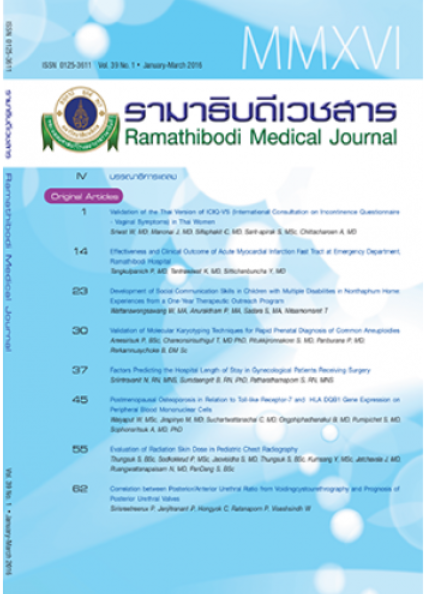Development of Social Communication Skills in Children With Multiple Disabilities in Nonthaphum Home: Experiences from a One-Year Therapeutic Outreach Program
Main Article Content
Abstract
Background and Purpose: The purpose of this study is to investigate the development of social communication skills in 37 children with multiple disabilities. These children are residents of Pakkret Home (Nonthaphum Home) the provided services for individuals with various disabilities. They were identified as having speech and language disorders through the provision of a one-year therapeutic outreach program.
Method: Participants were 37 children residents of Pakkret Home who ranged in age from 7 to 19 years. The clinicians employed a naturalistic approach emphasizing on the non-structured protocol and interaction adjusted to the children’s interests for one year. A pre- and post- intervention was evaluated by counting the number of communication circles.
Results: Participants demonstrated a significant increase in the use of communication circles following intervention (P < 0.05).
Conclusion: All participants showed significant improvement in the communication ability as identified by the pre- and post-intervention evaluation of the numbers of communication circles. Their social and emotional developments were also improved.
Article Details
References
Hunt N, Marshall K. Exceptional children and youth. 4th ed. New York: Houghton Mifflin Company; 2006, p444.
National Joint Committee for the Communicative Needs of Persons With. Severe Disabilities. Guidelines of Meeting the Communication Needs of Persons with Severe Disabilities. ASHA. 1992;34:1-8.
Dattilo J, Camarata S. Facilitating conversation through self-initiated augmentative communication treatment. J Appl Behav Anal. 1991;24(2):369-78.
Dyches TT, Davis A, Lucido B, Young J. Generalization of skills using pictographic and voice output communication devices, Augment Altern Comm. 2002;18:124-31. doi:10.1080/07434610212331281211.
Eckert SP. Teaching the social skill of accepting criticism to adults with developmental disabilities. Educ Train Ment Retard Dev Disabil. 2000;35:16-24.
Hunt P, Alwell M, Goetz L, Sailor W. Generalized effects of conversation skill training. Journal of the Association for Persons with Severe Disabilities. 1990;15:250-60.
Kelly MA, Foreman P, Bennett D, Pascoe S. Interaction inclusion and students with profound and multiple disabilities: towards an agenda for research and practice. J Res Spec Educ Needs. 2008;8:161-6.
Intasiri T. The construction of the Thai syntactic development test for children aged 3-7. Years old in Bangkok Metropolitan (master’s thesis). Thailand: Mahidol University; 2000.
Greenspan SL, Serena W. The child with special needs: encouraging intellectual and emotional growth. Philadephia, PA: Perseus Books. 1998; p164-74.
